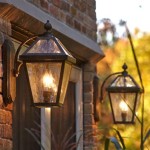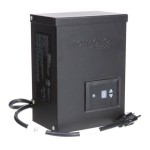Outdoor Landscape Lighting Techniques: Illuminating Your Outdoor Space
Outdoor landscape lighting is a multifaceted design element that enhances the aesthetic appeal, safety, and usability of exterior spaces. Employing various techniques allows homeowners and landscape architects to strategically illuminate gardens, pathways, architectural features, and water elements, transforming them into inviting and secure environments. The selection and implementation of appropriate lighting techniques require careful consideration of design principles, energy efficiency, and the specific characteristics of the landscape.
Effective landscape lighting involves more than simply placing fixtures around the perimeter of a property. It requires a comprehensive understanding of how light interacts with different textures, colors, and forms. The goal is to create a cohesive and visually appealing scene that complements the existing landscape design and highlights its most attractive features.
Highlighting Key Landscape Features
One of the primary functions of outdoor landscape lighting is to accentuate specific elements within the landscape. This can be achieved through various techniques, each offering a distinct effect. Uplighting, downlighting, spotlighting, and shadowing are among the most common methods used to draw attention to architectural details, specimen trees, sculptures, and water features.
Uplighting: This technique involves placing light fixtures at ground level and directing the light upwards, illuminating the trunk and canopy of a tree, the facade of a building, or a sculptural element. Uplighting creates a dramatic effect, emphasizing the height and form of the object being illuminated. The choice of fixture and beam angle will determine the intensity and spread of the light, allowing for customization depending on the size and shape of the target.
Downlighting: Conversely, downlighting involves mounting fixtures higher up, such as on tree branches, eaves of a house, or pergolas, and directing the light downwards. Downlighting mimics the natural effect of moonlight, creating a soft, diffused illumination that is ideal for lighting pathways, patios, and garden beds. This technique is particularly effective for creating a sense of intimacy and security in outdoor spaces.
Spotlighting: Spotlighting uses focused beams of light to highlight specific details or focal points within the landscape. This technique is well-suited for illuminating individual flowers, sculptures, or architectural details that warrant special attention. The intensity and beam angle of the spotlight can be adjusted to achieve the desired level of emphasis.
Shadowing: Utilizing the principle of light and shadow, this technique involves strategically positioning light fixtures to create interesting shadows on walls, fences, or other surfaces. This can be achieved by placing a light source behind a plant or sculptural element, allowing its silhouette to be projected onto the background. Shadowing adds depth and dimension to the landscape, creating a more dynamic and visually engaging environment.
The success of highlighting key landscape features depends on the careful selection of light fixtures, their placement, and the intensity of the light. It is crucial to avoid over-lighting, which can flatten the landscape and create unwanted glare. A balanced approach that emphasizes key features while maintaining a sense of overall harmony is essential.
Enhancing Safety and Security
Beyond aesthetics, outdoor landscape lighting plays a crucial role in enhancing the safety and security of a property. Well-lit pathways, entrances, and potential hazards can significantly reduce the risk of accidents and deter criminal activity. Strategic placement of lighting fixtures can provide clear visibility, making it easier to navigate the landscape at night and discouraging intruders.
Pathway Lighting: Illuminating pathways is essential for preventing trips and falls. Low-level path lights, bollard lights, or recessed lights can provide subtle and unobtrusive illumination, guiding pedestrians along walkways without creating glare. The spacing and intensity of path lights should be carefully considered to ensure adequate visibility without being overly bright.
Entrance Lighting: Well-lit entrances create a welcoming and secure atmosphere for residents and visitors. Porch lights, sconces, or floodlights can be used to illuminate doorways and surrounding areas, making it easier to see who is approaching and deterring unwanted visitors. Motion-activated lights can also be used to provide an extra layer of security, automatically turning on when movement is detected.
Security Lighting: Properly placed security lighting is crucial for deterring intruders and protecting a property. Floodlights, strategically positioned to illuminate dark corners, alleys, and vulnerable areas, can significantly reduce the risk of break-ins. Motion-activated security lights are particularly effective, as they provide a sudden burst of light that can startle potential intruders and alert residents to their presence.
When implementing safety and security lighting, it is important to consider the impact on neighbors and the surrounding environment. Overly bright lights can create light pollution and disrupt the natural environment. Utilizing shielded fixtures that direct light downwards can minimize glare and light trespass, ensuring that the lighting serves its intended purpose without causing unnecessary disturbance.
Creating Ambiance and Atmosphere
Outdoor landscape lighting can also be used to create a specific ambiance or atmosphere in an outdoor space. The color, intensity, and direction of light can all contribute to the overall mood, transforming a garden or patio into a relaxing retreat, an inviting entertainment area, or a romantic getaway. Techniques such as color washing, moonlighting, and the use of decorative fixtures can be employed to achieve the desired effect.
Color Washing: This technique involves using colored lights to wash a wall, fence, or other surface with a specific hue. Color washing can be used to create a dramatic effect, highlight architectural features, or simply add a touch of whimsy to the landscape. The choice of color will depend on the desired mood, with warmer colors such as amber and orange creating a cozy and inviting atmosphere, while cooler colors such as blue and green creating a more tranquil and serene effect.
Moonlighting: As mentioned earlier in Downlighting, moonlighting mimics the natural effect of moonlight by positioning fixtures high in trees and directing the light downwards. This technique creates a soft, diffused illumination that is ideal for creating a romantic and relaxing atmosphere. Moonlighting can be enhanced by using fixtures that cast a warm, slightly blueish light, further replicating the appearance of natural moonlight.
Decorative Fixtures: The selection of decorative light fixtures can also contribute to the overall ambiance of an outdoor space. String lights, lanterns, and decorative sconces can add a touch of charm and personality to patios, porches, and gardens. The style and design of the fixtures should complement the overall aesthetic of the landscape and the architecture of the house.
Creating the desired ambiance through landscape lighting requires a careful understanding of the principles of color psychology and the effects of different lighting techniques. Experimenting with different colors, intensities, and fixture styles can help homeowners achieve the perfect mood for their outdoor space.
In addition to the techniques already mentioned, other methods can further enhance outdoor landscape lighting designs. These include underwater lighting for ponds and fountains, which adds a mesmerizing element to water features, and silhouette lighting, which creates dramatic outlines of plants or objects against a lighted background.
The selection of the appropriate type of lighting fixture is also crucial. Options include LED lights, which are energy-efficient and long-lasting; halogen lights, known for their bright, white light; and solar lights, which offer a sustainable and wireless lighting solution. Each type has its own advantages and disadvantages in terms of cost, energy consumption, and light quality.
Proper installation of outdoor landscape lighting is essential for ensuring safety and longevity. It's crucial to use weatherproof fixtures and wiring, bury cables properly to prevent damage, and follow all local electrical codes. Consulting with a professional landscape lighting designer or electrician is recommended to ensure a safe and effective installation.
Maintenance is another key aspect of landscape lighting. Regularly cleaning fixtures, replacing bulbs, and trimming vegetation that obstructs the light can help maintain the effectiveness and appearance of the lighting system. Regular inspections can also identify potential problems, such as damaged wiring or malfunctioning fixtures, before they become major issues.
Integrating smart technology into landscape lighting systems is becoming increasingly popular. Smart lighting systems allow homeowners to control their outdoor lights remotely, adjust brightness and color, and set schedules for automatic operation. These systems can also be integrated with other smart home devices, such as security systems and thermostats, for a more seamless and automated experience.
The principles of sustainable lighting should always be considered in landscape lighting design. Using energy-efficient fixtures, such as LEDs, and minimizing light pollution are important steps in reducing the environmental impact of outdoor lighting. Shielded fixtures that direct light downwards can help prevent light trespass and protect the natural environment.
Outdoor landscape lighting offers many possibilities for transforming outdoor spaces into beautiful, safe, and functional environments. By understanding the nuances of different lighting techniques, considering the various factors involved, and possibly consulting with professional experts, homeowners can create outdoor lighting designs that enhance their landscape and provide enjoyment for many years to come.

Landscape Lighting Techniques And Types

3 Common Techniques We Use When Lighting Your Landscape Linnemann Lawn Care Landscaping Blog

Types Of Outdoor Lighting Techniques Grandview

Landscape Lighting Techniques And Types

Outdoor Accent Landscape Lighting Guide Delmarfans Com

Landscape Lighting Types Outdoor Lights Backyard Nptpool Com

5 Popular Landscape Lighting Techniques That Wow Lux

Tree Uplighting Techniques For Spring 1stoplighting

Landscape Lighting Techniques Drost

The Best Lighting Techniques For Your Landscape Garden Light Led
Related Posts







